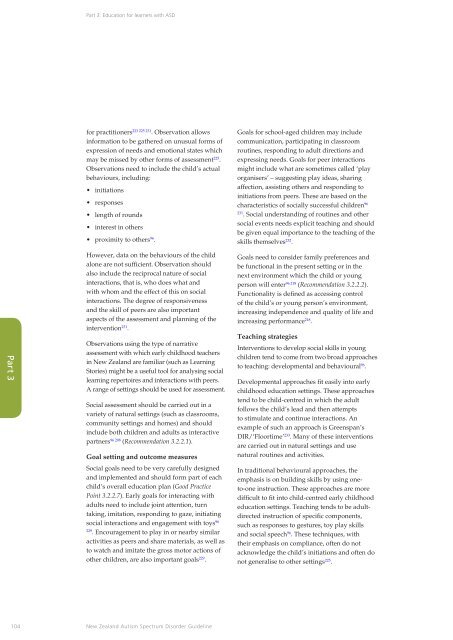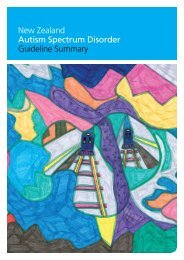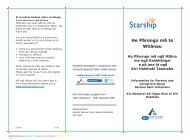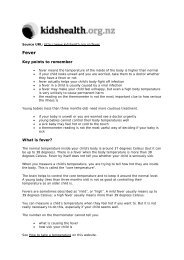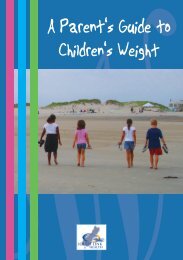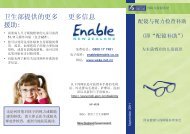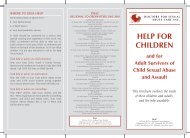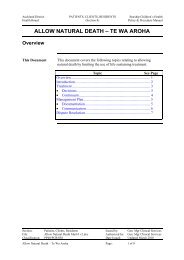New Zealand Autism Spectrum Disorder Guideline - Ministry of Health
New Zealand Autism Spectrum Disorder Guideline - Ministry of Health
New Zealand Autism Spectrum Disorder Guideline - Ministry of Health
Create successful ePaper yourself
Turn your PDF publications into a flip-book with our unique Google optimized e-Paper software.
Part 3: Education for learners with ASD<br />
for practitioners 223 225 231 . Observation allows<br />
information to be gathered on unusual forms <strong>of</strong><br />
expression <strong>of</strong> needs and emotional states which<br />
may be missed by other forms <strong>of</strong> assessment 225 .<br />
Observations need to include the child’s actual<br />
behaviours, including:<br />
• initiations<br />
• responses<br />
• length <strong>of</strong> rounds<br />
• interest in others<br />
• proximity to others 96 .<br />
Goals for school-aged children may include<br />
communication, participating in classroom<br />
routines, responding to adult directions and<br />
expressing needs. Goals for peer interactions<br />
might include what are sometimes called ‘play<br />
organisers’ – suggesting play ideas, sharing<br />
affection, assisting others and responding to<br />
initiations from peers. These are based on the<br />
characteristics <strong>of</strong> socially successful children 96<br />
231<br />
. Social understanding <strong>of</strong> routines and other<br />
social events needs explicit teaching and should<br />
be given equal importance to the teaching <strong>of</strong> the<br />
skills themselves 232 .<br />
Part 3<br />
However, data on the behaviours <strong>of</strong> the child<br />
alone are not sufficient. Observation should<br />
also include the reciprocal nature <strong>of</strong> social<br />
interactions, that is, who does what and<br />
with whom and the effect <strong>of</strong> this on social<br />
interactions. The degree <strong>of</strong> responsiveness<br />
and the skill <strong>of</strong> peers are also important<br />
aspects <strong>of</strong> the assessment and planning <strong>of</strong> the<br />
intervention 231 .<br />
Observations using the type <strong>of</strong> narrative<br />
assessment with which early childhood teachers<br />
in <strong>New</strong> <strong>Zealand</strong> are familiar (such as Learning<br />
Stories) might be a useful tool for analysing social<br />
learning repertoires and interactions with peers.<br />
A range <strong>of</strong> settings should be used for assessment.<br />
Social assessment should be carried out in a<br />
variety <strong>of</strong> natural settings (such as classrooms,<br />
community settings and homes) and should<br />
include both children and adults as interactive<br />
partners 96 208 (Recommendation 3.2.2.1).<br />
Goal setting and outcome measures<br />
Goals need to consider family preferences and<br />
be functional in the present setting or in the<br />
next environment which the child or young<br />
person will enter 96 218 (Recommendation 3.2.2.2).<br />
Functionality is defined as accessing control<br />
<strong>of</strong> the child’s or young person’s environment,<br />
increasing independence and quality <strong>of</strong> life and<br />
increasing performance 218 .<br />
Teaching strategies<br />
Interventions to develop social skills in young<br />
children tend to come from two broad approaches<br />
to teaching: developmental and behavioural 96 .<br />
Developmental approaches fit easily into early<br />
childhood education settings. These approaches<br />
tend to be child-centred in which the adult<br />
follows the child’s lead and then attempts<br />
to stimulate and continue interactions. An<br />
example <strong>of</strong> such an approach is Greenspan’s<br />
DIR/‘Floortime’ 233 . Many <strong>of</strong> these interventions<br />
are carried out in natural settings and use<br />
natural routines and activities.<br />
Social goals need to be very carefully designed<br />
and implemented and should form part <strong>of</strong> each<br />
child’s overall education plan (Good Practice<br />
Point 3.2.2.7). Early goals for interacting with<br />
adults need to include joint attention, turn<br />
taking, imitation, responding to gaze, initiating<br />
social interactions and engagement with toys 96<br />
229<br />
. Encouragement to play in or nearby similar<br />
activities as peers and share materials, as well as<br />
to watch and imitate the gross motor actions <strong>of</strong><br />
other children, are also important goals 229 .<br />
In traditional behavioural approaches, the<br />
emphasis is on building skills by using oneto-one<br />
instruction. These approaches are more<br />
difficult to fit into child-centred early childhood<br />
education settings. Teaching tends to be adultdirected<br />
instruction <strong>of</strong> specific components,<br />
such as responses to gestures, toy play skills<br />
and social speech 96 . These techniques, with<br />
their emphasis on compliance, <strong>of</strong>ten do not<br />
acknowledge the child’s initiations and <strong>of</strong>ten do<br />
not generalise to other settings 225 .<br />
104<br />
<strong>New</strong> <strong>Zealand</strong> <strong>Autism</strong> <strong>Spectrum</strong> <strong>Disorder</strong> <strong>Guideline</strong>


